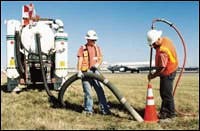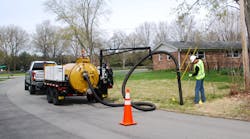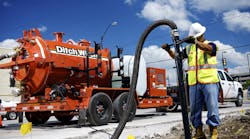What is the most versatile construction machine? Many equipment users would answer the backhoe-loader; others might say it's the skid-steer loader with multiple attachments. However, there may be another contender for "most versatile" honors: the vacuum excavator.
This dual-function machine was a well-kept equipment secret for more than 40 years. Used by specialty contractors since the 1950s, compact trailer-mounted vacuum excavator models began appearing on utility construction sites in the mid-'90s, primarily supporting horizontal directional drilling (HDD) operations.
A vacuum excavator is a portable vacuum system and a "soft" excavator, able to make small, precisely controlled excavations with a powerful stream of pressurized water or high-pressure air. Spoil is sucked up by the machine's vacuum hose. Primary functions on HDD jobs are digging potholes to visibly identify locations of existing buried pipe and cable and to vacuum up drilling fluids that flow from bore holes during drilling and backreaming.
But the value of vacuum excavators extends far beyond supporting HDD.
Potholing is necessary—and sometimes mandated—on many projects, and soft excavation is recognized as the most efficient, safest way to pothole, eliminating the risk of damaging buried utilities inherent with all mechanical equipment and tools. Soft excavation is appropriate for many other excavation needs as well.
For example, Mid-America Drilling Services, an environmental contractor in Elburn, Ill., uses vacuum excavation to pothole on remediation sites before drilling test holes and prior to installing monitoring wells or remediation well screen to clean up underground contamination.
"Vacuum excavation potholing allows us to confirm exact locations of buried utilities, reducing the risk of damage," says Mike Crimaldi, field operations manager. "Some of our clients require potholing on every job."
In Denver, Concrete Express, a concrete and utility contractor, used a vacuum excavator to dig caissons for installation of a sound wall along a busy expressway. "Normally caisson excavations are made with vertical drilling equipment," says Xernie Meritt, Concrete Express president. "But we couldn't do that because the easement where the wall had to go is filled with utilities."
The company used a truck-mounted air vacuum-excavation unit to dig caissons 2 feet in diameter, 6 feet deep along the highway. Concrete support columns then were poured into the caissons to support 8-foot-high wall sections. The machine also was used to uncover/excavate around utilities when relocation was necessary to make room for caissons. Concrete Express also uses vacuum-excavation equipment for potholing on other road projects.
Pole-line contractors use vacuum excavators to dig holes for utility and light poles in crowded easements where use of conventional methods is difficult or impossible. "Any time we set utility poles in highly sensitive areas—near high pressure gas lines, fiber optic cable, and in downtown areas—we dig holes by vacuum excavation instead of with augers," says Randy McAlvain, construction superintendent, Terra-Tech, Oklahoma City. "Vacuum excavation is routine in such situations because it reduces the risk of hitting utilities that are already in the ground."
Vacuum excavators are playing a growing role with subsurface utility engineering (SUE) projects. They are being used extensively with a $2.4 billion capital improvements program now under way at Seattle-Tacoma (Sea-Tac) International Airport.
Utility-locating contractor Applied Professional Services (APS), North Bend, Wash., uses truck-mounted vacuum-excavation systems to pothole existing buried utilities. Information compiled on each pothole includes pothole number, depth from surface to top and bottom of pipe, width of duct banks, and utility identification. Data is used to update as-built CADD maps throughout the design and construction.
William D. Massengill, APS president, estimates his crews have made approximately 400 vacuum-excavation potholes for several separate projects during the course of the airport work. Most soft excavations were made by high-pressure air excavation equipment mounted on trucks.
Redi Industrial Services may hold the record for potholes completed on one project. In one five-month period, the Lyman, Wyo., contractor's crews dug more than 4,000 potholes across four western states in conditions so rugged that Caterpillar crawlers often had to pull big vacuum excavation trucks up grades as steep as 75 percent. The work was in conjunction with the expansion of the Kern River natural gas pipeline, laying new pipe parallel to an existing pipeline along a 717-mile route.
Vacuum excavation was the only way the potholes could be dug. "Excavation is not allowed within 2 feet of the active pipeline," explains Les Patterson, Redi Industrial Services vice president. "However, non-destructive hydro-excavation was permitted because it does not pose a risk of damage as does digging with mechanical equipment."
Potholes were made at every pipe side bend, road crossing, at pipe inverts, and at locations that required large side hill cuts adjacent to the existing pipeline. When the route went through washes, the locates were made at the bottom of the pipe's sag bend. Potholes also identified locations of other utilities in the pipeline easement. Sizes of excavations ranged from 8 inches in diameter and 4-foot depths, to 5-foot diameters and 23-foot depths.
Three 410-hp vacuum excavators using pressurized water for excavation worked 10-hour days, six days a week, to complete the work. A fourth unit was employed on some segments of the project.
Although potholing is the most common digging job for vacuum excavators, the machines are also ideal for other projects. Types of jobs include digging small holes to access damaged underground pipe and cable to make repairs, uncovering pipe joints and fittings, cutting off service lines and plugging unused pipelines, attaching cathodic protection anodes for corrosion protection, and almost any other purpose that requires a small, neat hole.
Contractors also employ vacuum excavators for digging horizontal trenches in areas where conventional equipment can't operate and to tunnel under sidewalks and driveways. As powerful, portable vacuum units, the machines have unlimited potential.
The machines are used routinely to clean out manholes, vaults, conduit and pipe, storm sewer grates and catch basins, and to clean up cuttings from sawing through pavement. Telecom and electrical contractors draw pulling rope and cable through ducts and conduits with the vacuum.



